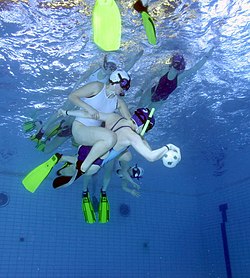A water polo cap is a piece of headgear used in water polo and a number of underwater sports. The caps are used to identify both the player and their team, and to protect their ears from injury possibly caused by a water polo ball hitting the head.
Use for water polo
[edit]Caps are differentiated by the number printed on them as well as the color. Players from the visiting team will wear dark caps, whereas the home team players will wear white caps. The goalkeepers wear quartered red caps, numbered "1", while substitute goalies have caps which are either numbered "1-A" in NCAA games, or "13" in FINA international games.[1] Thus, each team will have two sets of caps: one white and the other dark colored. According to the NFHS water polo uniform rules, the numbers on the cap contrast the color of the cap, and both the color of the cap and the color of the number contrast the color of the ball.[2]
Use by underwater sports disciplines
[edit]In underwater football, underwater hockey and underwater rugby, water polo caps are worn by competitors to identify which teams they are playing for, and to offer some protection to individuals against the possibility of a burst eardrum caused by the blade of a fin making direct contact across the ear.[3][4][5][6] Opponents in underwater hockey and underwater rugby wear either one of two colours - white or dark (i.e. blue or black) caps while the water referees wear red caps.[7][8] Underwater football appears to follow this precedent.[9] Caps are also used in Aquathlon (underwater wrestling) for identification purposes; one competitor wears either a red or blue coloured cap while the other competitor wears a white or yellow coloured cap.[10]
Gallery
[edit]-
A field player cap
-
A goalkeeper cap
-
Underwater hockey players wearing water polo caps
-
Underwater rugby players wearing water polo caps
See also
[edit]References
[edit]- ^ "WP4 Caps". Fédération Internationale de Natation. Retrieved 31 March 2013.
- ^ "Archived copy". Archived from the original on 20 June 2018. Retrieved 20 June 2018.
{{cite web}}: CS1 maint: archived copy as title (link) - ^ "Underwater Football. Rules and Regulations". Sean Ennis. Retrieved 2 April 2013.
- ^ "International Rules for Underwater Hockey. Tenth Edition". Confédération Mondiale des Activités Subaquatiques. p. 5. Retrieved 29 March 2013.
- ^ Landsberg PG (December 1976). "South African Underwater Diving Accidents, 1969–1976" (PDF). SA Medical Journal. 50 (55): 2156. PMID 1013870. Archived from the original (PDF) on 30 September 2013. Retrieved 29 March 2013.
- ^ "CMAS Under Water Rugby Rules August 2011". Confédération Mondiale des Activités Subaquatiques. p. 12. Retrieved 29 March 2013.
- ^ "International Rules for Underwater Hockey Volume 2. Tenth Edition". Confédération Mondiale des Activités Subaquatiques. pp. 5 & 9. Retrieved 29 March 2013.
- ^ "CMAS Under Water Rugby Rules August 2011". Confédération Mondiale des Activités Subaquatiques. pp. 13 & 17. Retrieved 29 March 2013.
- ^ "The Gear – Personal Equipment". Sean Ennis. Retrieved 31 March 2013.
- ^ "Aquathlon International Rules version 2012/01". Confédération Mondiale des Activités Subaquatiques. p. 2. Retrieved 2 April 2013.
| Basics |
| ||||||
|---|---|---|---|---|---|---|---|
| Equipment | |||||||
| Techniques | |||||||
| Positions & strategy |
| ||||||
| Geography |
| ||||||
| Variations | |||||||
| Western culture |
| ||||||||||||||||||||||||
|---|---|---|---|---|---|---|---|---|---|---|---|---|---|---|---|---|---|---|---|---|---|---|---|---|---|
| Folk |
| ||||||||||||||||||||||||
| Wrapped headwear | |||||||||||||||||||||||||
| Hat parts | |||||||||||||||||||||||||
| Accessories | |||||||||||||||||||||||||
This water polo-related article is a stub. You can help Wikipedia by expanding it. |




